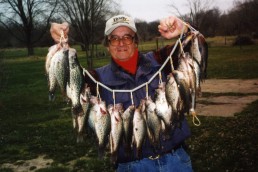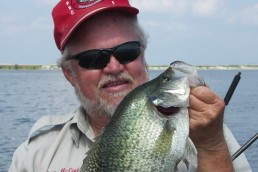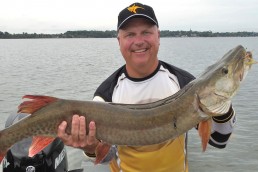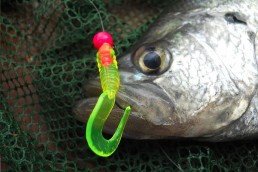Shallow and Accessible: Prime-time Crappies
SHARE THIS POST
Daytime air temperatures have been up and down as is normal for most springs, but May should be a prime month for crappie action.
Location
Most pre-spawn movements will be into shallow water. The shallower water warms quicker, and it’s here where the warming rays of the sun start the aquatic food chain. The composition of the bottom is also a factor in these shallows. Mud-bottomed areas retain heat longer than areas of a harder bottom. It’s in these black-bottomed bays of natural lakes and the back ends of coves on reservoirs where the first plant growth begins. Plants provide oxygen and feeding opportunities and provide protective cover.
The position and angle of the sun now favors the north or northwest portions of a body of water, raising water temperatures just a few degrees here over the other parts of a lake. Early-spring warming trends with south or southwest winds push the warmer surface waters toward the northern shorelines and pile up the warmer water along with the plankton carried by the currents. Also, cold fronts with northerly winds will have a lesser effect along the northern shoreline because the north sides will be more protected from the winds.
Another area to look for crappies would be where a creek, ditch or river enters the main lake. Current is always a factor in drawing baitfish, and run-off is often warmer than water in the main lake. Crappies are very sensitive, even with a subtle change of a few degrees.
Marinas with a muck bottom can also attract them, with piers and pilings providing cover and food in the form of tiny plants and animals. Shallow channels off the main body of water are other areas to try. These channels may lead to cottages or summer homes or can connect one body of water to another. Roads crossing a body of water often result in bridges. The pilings offer cover and the current passing through from one body or water to another will attract the baitfish and crappies.
For your search along the northern shoreline, be aware of conditions after a cold front passes through and north winds blowing for a day or two. This is when it might be time to change your searching tactics. Several days of north winds will push the warmer surface waters toward the southern portion of a lake. When this happens, you might have better luck trying marinas, channels, ditches and coves along the southern shoreline.
Are you enjoying this post?
You can be among the first to get the latest info on where to go, what to use and how to use it!
It’s not necessary to have a boat to get in on some of this action. Many prime fishing areas will be accessible to the shore fisherman. Some areas might even be easier to fish from shore or next to impossible to approach with a boat without spooking the crappies. Public access may be available to marinas and along the ditches and tiny feeder creeks, but private property along these shallow, connecting channels may be fished, if you get permission.
Presentation
I fish spring crappies one of three ways, depending upon their activity level. When the water is very cold right after ice-out or after a cold front, these fish are lethargic and require a basic presentation. Try a number 10 or 12 Aberdeen hook, some small split shot and a Thill Mini Stealth Float. A bee moth or a small fathead minnow often produce best under these conditions. Another option is Berkley’s Gulp Alive 1- or 2-inch minnows. When using these tiny baits with a finesse-type presentation, I use a quality line like Berkley Sensation in 4-pound test. When I’m working the heaviest cover (sunken brush, fallen trees or thick weeds) I will upgrade to a heavier line.
When crappies are more aggressive or during a warming trend I’ll switch to a 1/64-ounce glow-in-the-dark or chartreuse jig head instead of the plain hook. The addition of this bit of color works better for me under these conditions. I’ll then tip the plain jig head with the bee moth or small minnow, depending on the crappie’s preference for that day. The rest of my setup remains the same: a Thill Mini Stealth and tiny split shot.
As water temperatures rise, I try another type of presentation. These crappies are more aggressive now with feeding, and I try to take advantage of this by using a more aggressive approach as well. A 1/32-ounce Lindy Fuzz-E-Grub jig in Pink/White or their Chartreuse/Black is my first choice. Another option would be a 1/32-oune jig with a white or lime-green 2-inch twister-tail grub. My next choice for these fish would be the old Blakemore Road Runner in 1/16 ounce in White, Chartreuse or Black and Chartreuse.
As a general rule, when using a float for crappies I set my float one-third to one-half of the depth of water I’m fishing. For example, if I’m fishing in 3 feet, my float will be set at 12 to 18 inches. If I’m fishing 6 feet of water, my float will then be set so my bait is down 2 to 3 feet. Crappies usually look up for their meals, and this general rule and technique has worked well for me.
MWO
SHARE THIS POST
Did you enjoy this post?
You can be among the first to get the latest info on where to go, what to use and how to use it!
Bill Takacs
Bill Takacs of Hammond, Ind., has been writing for MidWest Outdoors regularly since 1975, and has been published in several state, regional and national publications. He fishes for virtually every freshwater fish from panfish to muskies, with the exceptions of sturgeon and alligator gar.



